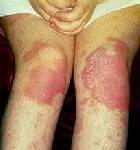|
Psoriatic ArthritisPsoriatic arthritis (PsA) is a chronic, autoimmune (caused by your own immune system) disease of the skin, characterized by an overproduction of skin cells resulting in lesions that are red, dry, raised and scaly. These patches can appear anywhere on the body, but occur particularly on the elbows, knees, scalp and lower back. PsA is a rheumatic condition (disease of joints), also autoimmune in origin, that occurs in more than 10% of PsA sufferers eventually. Most often (85% of the time) the skin lesions appear before the joint problems, often by as much as 20 years.
It is estimated that approximately 600,000 Americans have psoriatic arthritis. The disease may strike at any time, but most often develops between the ages of 30 and 55. If left untreated, people with psoriatic arthritis are at risk of permanent joint damage.
"There are five types of the disease: symmetric, asymmetric, distal inter-phalangeal predominant (DIP), spondylitis and arthritis mutilans. Symmetric arthritis is much like rheumatoid arthritis but generally milder with less deformity. It usually affects multiple symmetric pairs of joints (occurs in the same joints on both sides of the body) and can be disabling. Distal inter-phalangeal predominant (DIP) although the "classic" type, occurs in only about 5 percent of people with psoriatic arthritis. Primarily, it involves the distal joints of the fingers and toes (the joint closest to the nail). Sometimes it is confused with osteoarthritis, but nail changes are usually prominent. Spondylitis is inflammation of the spinal column. In about 5 percent of individuals with psoriatic arthritis, spondylitis is the predominant symptom. Inflammation with stiffness of the neck, lower back, sacroiliac or spinal vertebrae are common symptoms in a larger number of patients, making motion painful and difficult. Peripheral disease can be present in the hands, arms, hips, legs and feet. Arthritis mutilans is a severe, deforming and destructive arthritis that affects fewer than 5 percent of people with psoriatic arthritis. It principally affects the small joints of the hands and feet, though there is frequently associated neck or lower back pain."
Up to 40% of people with this disease have a first degree relative with the same disease. If you have an identical twin with PsA, your chance of developing the same disease is 75%. Both psoriasis and PsA are chronic diseases that worsen over time although a clinical course with flares and remissions is common. The severity of the skin lesions does not necessarily correlate with the severity of the disease.
Go to Psoriatic Arthritis Signs
|

"We hope you enjoy your journey through Bone and Joint Pain.com"
 PsA is a lifelong disease of the immune system that causes raised, red patches, often with a silvery scale (psoriatic skin lesions), to appear on the skin, as well as pain, stiffness, or swelling in joints.
PsA is a lifelong disease of the immune system that causes raised, red patches, often with a silvery scale (psoriatic skin lesions), to appear on the skin, as well as pain, stiffness, or swelling in joints. 